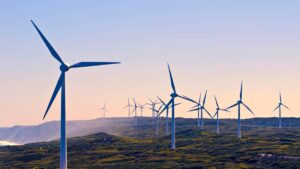SEC calls for emission transparency as Woodmac urges faster adoption of net-zero

Following a 3-1 SEC vote on Monday, public listed companies will be required to report on climate risks. Pic: Getty Images
- Under a new federal proposal, public listed companies will be required to report on climate risks
- The proposal requires companies to highlight Scope, 1, 2, and 3 greenhouse gas emissions
- While many organisations voluntarily do this, there are widespread discrepancies
In a move that could further accelerate the global transition to net-zero, Wall Street’s top regulator, the US Security Exchange Commission (SEC), says companies must disclose their greenhouse gas emissions as well as the risks that climate change poses for their business under a new federal proposal.
Following a 3-1 SEC vote on Monday, public listed companies will be required to report on climate risks, the costs of moving away from fossil fuels, and the risks related to impacts of climate events caused by global warming.
Set to turn the disclosure regime on its head, the proposal will also require companies to paint an accurate picture of its present and prospective performance by highlighting direct greenhouse gas emissions (GHG) (Scope 1) and indirect emissions from purchased electricity or other forms of energy (Scope 2).
This also includes GHG emissions from upstream and downstream activities in its value chain (Scope 3) and if the company has set a GHG emissions target or goal that includes Scope 3 emissions.
Limiting global warming amid market uncertainty
While many organisations share voluntary details about their emissions, there are widespread discrepancies with how carbon emissions are reported, and the new proposal seeks to provide a standardised approach to measure and disclose GHG emissions.
This push for greater transparency could accelerate efforts to address emissions generated by these companies, which dovetails with Woodmac’s call for the world to double-down on plans to achieve limiting global temperatures to 1.5 degrees Celsius by 2050.
In its latest Accelerated Energy Transition (AET) 1.5-Degree scenario Report, Woodmac states strong demand recovery and a lack of investment in supply has caused prices to rise across sectors.
“Energy security and geopolitical tensions have added unprecedented uncertainty to markets across the globe and on top of that, countries and corporations still bear the massive challenge of limiting global warming to 1.5 ˚C,” it said.
Woodmac head of markets and transitions Americas David Brown said record commodity prices and recent geopolitical changes have highlighted the challenges in navigating the energy transition.
“The world is facing its biggest challenge yet in its journey towards net zero,” Brown highlighted.
“To remain on course, those most exposed to global commodity markets need to double-down on plans to decarbonise through electrification and other emerging, net-zero enabling technologies.
“Policy must be geared towards renewable growth and investment in grid infrastructure.”
Boundless opportunities to benefit from the net-zero transition
Although the journey to net zero might seem insurmountable at present, there are boundless opportunities for those willing to take a shot.
The report predicts electrification will dominate, providing 48% of the world’s energy consumption supported by the rapid deployment of wind and solar – which will account for 61% of a significantly larger power market globally by 2050.
“Meanwhile, hydrocarbons’ share of energy demand falls to 43% in 2050 compared to 89% today. Coal and oil demand decline nearly two-thirds during this period,” it says.
Natural gas is expected to be resilient, falling about 26%, supported by blue hydrogen production and carbon capture and storage (CCS) adoption in the power sector.
But central to the electrification of global economies is road transportation, Woodmac adds.
“Global electric vehicle stock is expected to rise to around 1.7 billion vehicles by 2050 in AET-1.5 and will require substantial investment in charging infrastructure which could reach 1 billion units,” Woodmac says.
Battery pack prices will continue to fall as regulatory supports grow and technologies advance, while an unprecedented growth in mine supply is required to deliver the raw materials to underpin electrification of the transport sector.
Metals costs will endure vast price cycles as demand booms and higher carbon costs are embedded into production. End-users will need to be cautious about near-term price volatility for battery raw materials caused by supply-demand disconnect or other disruptions.
Related Topics
UNLOCK INSIGHTS
Discover the untold stories of emerging ASX stocks.
Daily news and expert analysis, it's free to subscribe.
By proceeding, you confirm you understand that we handle personal information in accordance with our Privacy Policy.








